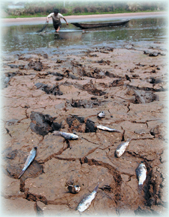5 Study Guide
 Interdependence in Nature
Interdependence in Nature
The way a population changes depends on many things, including its age structure, the rates at which individuals are added or removed from the population, and factors in the environment that limit its growth.
5.1 How Populations Grow
 Researchers study populations' geographic range, density and distribution, growth rate, and age structure.
Researchers study populations' geographic range, density and distribution, growth rate, and age structure.
 The factors that can affect population size are the birthrate, the death rate, and the rate at which individuals enter or leave the population.
The factors that can affect population size are the birthrate, the death rate, and the rate at which individuals enter or leave the population.
 Under ideal conditions with unlimited resources, a population will grow exponentially.
Under ideal conditions with unlimited resources, a population will grow exponentially.
 Logistic growth occurs when a population's growth slows and then stops, following a period of exponential growth.
Logistic growth occurs when a population's growth slows and then stops, following a period of exponential growth.
population density (131)
exponential growth (132)
age structure (131)
logistic growth (135)
immigration (132)
carrying capacity (135)
emigration (132)

5.2 Limits to Growth
 Acting separately or together, limiting factors determine the carrying capacity of an environment for a species.
Acting separately or together, limiting factors determine the carrying capacity of an environment for a species.
 Density-dependent limiting factors operate strongly when population density reaches a certain level. Density-dependent limiting factors include competition, predation, herbivory, parasitism, disease, and stress from overcrowding.
Density-dependent limiting factors operate strongly when population density reaches a certain level. Density-dependent limiting factors include competition, predation, herbivory, parasitism, disease, and stress from overcrowding.

 Density-independent limiting factors affect all populations in similar ways, regardless of population size and density. Unusual weather such as hurricanes, droughts, or floods, and natural disasters such as wildfires, can act as density-independent limiting factors.
Density-independent limiting factors affect all populations in similar ways, regardless of population size and density. Unusual weather such as hurricanes, droughts, or floods, and natural disasters such as wildfires, can act as density-independent limiting factors.
limiting factor (137)
density-dependent limiting factor (138)
density-independent limiting factor (140)

5.3 Human Population Growth
 The human population, like populations of other organisms, tends to increase. The rate of that increase has changed dramatically over time.
The human population, like populations of other organisms, tends to increase. The rate of that increase has changed dramatically over time.
 Birthrates, death rates, and the age structure of a population help predict why some countries have high growth rates while other countries grow more slowly.
Birthrates, death rates, and the age structure of a population help predict why some countries have high growth rates while other countries grow more slowly.
Think Visually Create a table in which you describe the phases of logistic growth.
Table of Contents
- Formulas and Equations
- Applying Formulas and Equations
- Mean, Median, and Mode
- Estimation
- Using Measurements in Calculations
- Effects of Measurement Errors
- Accuracy
- Precision
- Comparing Accuracy and Precision
- Significant Figures
- Calculating With Significant Figures
- Scientific Notation
- Calculating With Scientific Notation
- Dimensional Analysis
- Applying Dimensional Analysis




